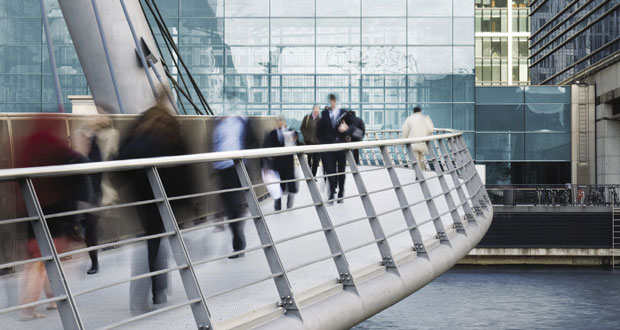Corporate Real Estate is going through something of a revolution at the moment as the impact of COVID-19 accelerates trends in health and wellbeing, hybrid working, and the use of technology to improve space utilisation. FMJ reports
The long-term effects of the pandemic on Corporate Real Estate is currently a subject of much debate, as conflicting research either suggests the commercial office is dead and gone or conversely workers will flock back to reoccupy buildings. The truth is somewhere in between. A global survey of members of CoreNet Global(i), the global association for corporate real estate found that those companies which anticipated having a smaller corporate footprint within the next two years, had fallen from 70 per cent in a previous survey to just over half. While nearly three quarters (70 per cent) did believe that the 9-5 work pattern was a thing of the past, it was with the caveat that the office will live on as a place for collaboration.
Karen Plum, Director of Research & Development at Advanced Workplace Associates (AWA) thinks many CRE leaders have been pushed to make the workplace COVID compliant, “at the behest of senior leaders, many of whom are keen to get everyone back to the office because that’s how they feel the organisation works best.
“To accommodate smarter working, I think that there will be a need for smarter spaces, designed around people and what they require to be able to undertake specific activities. The commercial property sector will also need to ensure the future office can easily accommodate those who don’t have suitable alternate space to work from.”
For FMs says Tom Carroll, Head of EMEA Corporate Research and Strategy, JLL: “One of the greatest legacies of the pandemic is the focus on individual health and wellbeing. A healthy working environment is now a fundamental for many employees considering a return to the office and companies are seeking to reinvent their office space to reflect the fact that health and wellbeing is a priority.”
He believes the adoption of more flexible ‘activity-based’ working will grow that encourages a ‘new normal’ where the office becomes a hub of social activity and collaboration rather than a place to tick tasks off.
Carroll explains: “According to JLL’s recent Shaping Human Experience report(ii), 74 per cent of employees look forward to the opportunity to return to the office. However, work patterns will continue to allow work from home, with 75 per cent expecting businesses to continue to support homeworking and 74 per cent even considering a four-day week. As such the purpose of the office will shift from the place where you work to the place where you connect. A location that focuses on brand, clients, co-workers and external partnerships.”
HYBRID WORKING
The lockdown hiatus has led to many organisations evaluating their real estate portfolios; in what Carroll describes as a “seismic shift towards a workforce-centric model, as employees are dispersed, digitally enabled and liquid like never before”.
He sees the future of work being more of a hybrid model with a firmer focus on the needs of the employee.
“These changes will characterise the workforce and working patterns in the next five years and this will inevitably impact the portfolio of the future workplace. Work from anywhere will drive footprint dispersion and portfolio transformation.”
When it comes to location, advises Julian Cooper, Managing Director at Clarendon, organisations will have to maintain a balancing act between what employees want and what’s best for their business. “If you want to find a space that is close to a lot of your employees, then it may be a suburban location, but if there are some teams that will be using the space more than others, perhaps a location more convenient for those employees will take priority.”
Alternatively, he says: “It may be that the majority of clients are centrally located and so it makes sense to have a workplace near them. Businesses may also want to prioritise collaborative spaces for larger teams, more meeting rooms and lounge-type spaces.
“This is why the hub and spoke model is gaining traction. It allows employees easy access to an office space with all of the usual amenities, as well as a place to collaborate and socialise with colleagues.”
Robin Davies, Business Development Director at Freespace believes a revolution in how space is utilised will result in an overall reduction of 20 per cent of corporate real estate within the built environment. He sees the hub and spoke model for corporate real estate taking a significant role in pandemic recovery. Where previously, a company HQ would house all departments, “the trend in regional hubs, or satellite offices, means employees have an easy reach of a workplace without the daily commute”.
This hub model is already being trialled within the public sector. In July 2018, the UK government released its plans for the One Public Sector Estate (OPE)(iii), a strategy designed to consolidate its assets to increase efficiency and to encourage local growth and collaboration.
Says Davies: “This major operational transformation in the UK public sector has seen public servants vacating hundreds of buildings across the country to occupy fewer and more efficient regional hubs. “As of January 2021, 17 hubs had been created as we accelerate towards the target of between 18 to 22. This includes the closure of 130 HMRC offices. Instead, former occupants of these buildings have now been placed into 13 regional hub centres.”
Given these new modes of working, should organisations even be maintaining corporate offices when they can encourage and support distributed work to save money on real estate? Despite a definite trend towards hybrid work systems, offices are still highly valued by employees argues Carroll. JLL data found that 70 per cent of employees find the office environment is more conducive to team-building and creative collaboration.
He explains: “Hybrid working patterns are driven by the simple fact that people really miss the office, above all the human interaction it offers. CEO sentiment has shifted through the pandemic and there is increasingly strong recognition of the value that the physical workplace brings to enterprise performance and culture.
“The cores of our cities will also be reimagined to reflect their changing role in the urban ecosystem. They will re-emerge as hubs of innovation, collaboration and interaction. With two thirds of employees expecting to be able to work from different locations post-crisis, we expect greater adoption of flexible and agile space formats within portfolios.”






